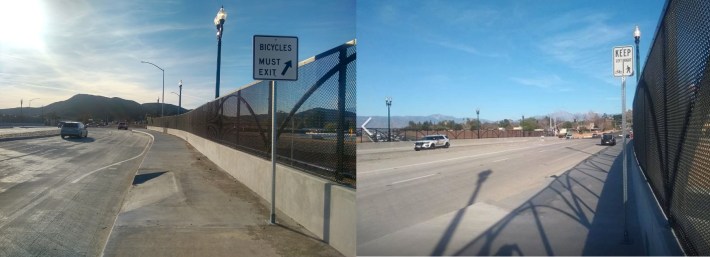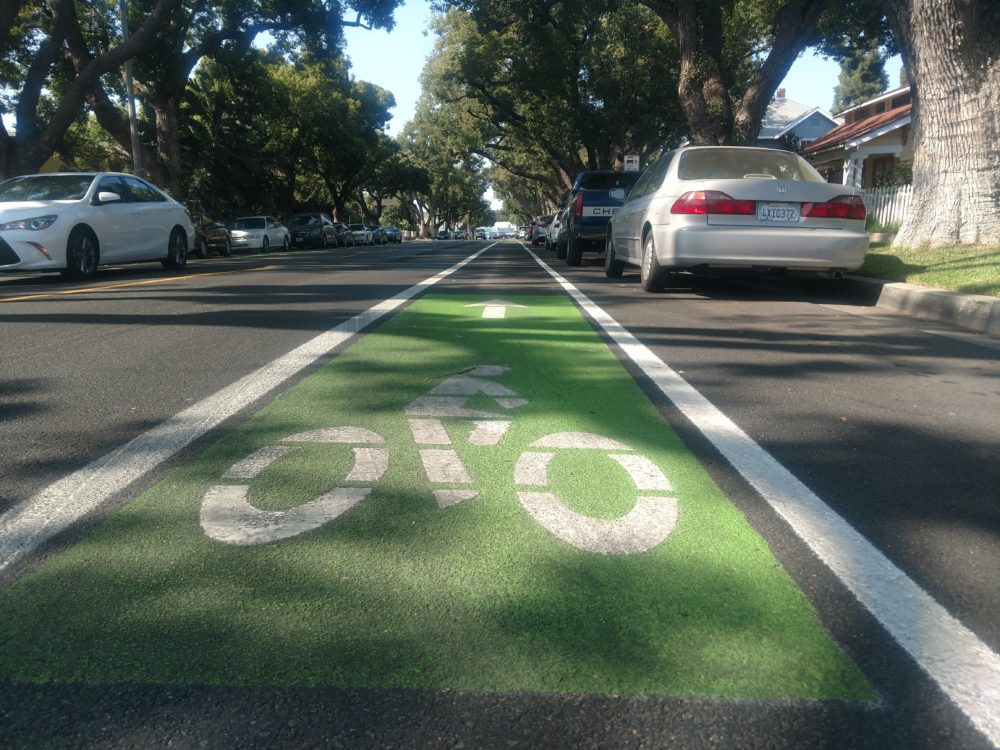Caltrans representatives told the CTC this week that the draft 2020 State Highway Operation and Protection Program (SHOPP) [PDF] reflects the department's commitment to incorporate bicycle, walking, and transit features in its highway maintenance projects "where feasible," in compliance with its Complete Streets policies.
Michael Johnson, an engineer with Caltrans' State Asset Management division, told the CTC that "Caltrans has a renewed focus on Complete Streets, and has been building on that commitment. Forty-one percent of all SHOPP projects include one or more complete streets features," he said, and "half include bike or pedestrian features."
"The Department has redoubled its efforts to look for opportunities to add additional meaningful Complete Streets elements to its highway projects," he said.
This is significant. Caltrans had argued last year that S.B. 127, the Complete Streets bill, was unnecessary because the department was was already doing this.
But going just by the draft SHOPP itself, it's impossible to ascertain to what extent this is true, or even what Caltrans means by "Complete Streets elements." The draft SHOPP contains only summary descriptions of each project, and breaks out only certain cost estimates, such as how much is spent on pavement or drainage. But it does not break out any detail about Complete Streets or active transportation elements.
Without more than a summary description, it isn't possible for residents--or likely even Caltrans, for that matter--to track what Complete Streets elements are being included in which projects. That also makes it hard to provide feedback on whether they are meaningful, and on whether they fit local needs.
Unfortunately Caltrans doesn't have a good track record on what constitutes good bicycle and pedestrian infrastructure. Examples of recent projects Caltrans has called "Complete Streets" (and even received at least one award for) include slapping sharrows onto high-speed roads designed with no space for a bike lane, squeezing narrow bike lanes into an already-planned project and blocking pedestrian crossings in the name of "safety," and forcing bicycle riders to share narrow sidewalk space with pedestrians because engineers can't figure out how to safely accommodate them in a brand-new roundabout.

Right now it is difficult to know what exactly Caltrans considers a "Complete Streets" element. There used to be a "Complete Streets Toolbox" available at the department's website, but the link seems to be broken. There is also some indication that Caltrans considers roundabouts to be Complete Streets improvements, and may count them in that 41 percent of SHOPP projects mentioned above--even though these expensive intersection redesigns benefit mostly car drivers, by eliminating signals, and can make conditions more dangerous and less convenient for people walking or biking.
Bjorn Griepenburg, Policy and Planning Director for the Marin County Bicycle Coalition, told Streetsblog about the difficulty his organization has had weighing in on a potential SHOPP project. He serves on the District 4 Bicycle Advisory Committee, and through that work found out that Caltrans is planning to repave Tiburon Blvd., which is State Route 131 in Marin. Tiburon is an important access road in and out of several communities, and is also a major bike route for the area. Weekend riders on the Golden Gate Bridge frequently end up on this 4-lane, 45 mph-plus road on their way to and from the bridge.
Repaving it is clearly an opportunity to install much-needed protected bike lanes along the route, Griepenburg told Streetsblog. But even though he serves on the BAC, he didn't know how--or when--to provide input to Caltrans.
"It's not clear how they handle it at the staff level," he said. "Do they wait until it's been adopted as part of the SHOPP before planning? At the same time, it sounded like once projects are adopted, they may move forward with little opportunity to weigh in. It wasn't clear when the best window was, or even if there was a window for input," he said.
The Marin Bike Coalition ended up sending a letter [PDF] to District 4, and received a response saying it would be further discussed if or when the project was adopted in the SHOPP. "Because we got this letter in," he said, "and because Sergio (Ruiz, D4's Bike and Pedestrian Coordinator) acknowledged it, and even just because we have Sergio working in the District, at least there's hope they will consider our request. Absent this, I'm not sure there would have been anything we could do."
How many other projects in the statewide SHOPP are projects that similarly provide an opportunity to improve conditions for people on foot and on bikes? Using just the SHOPP itself, there's no way to know.
The California Bicycle Coalition used the Public Records Act to request more detailed information about projects in the SHOPP, and after some delay succeeded in getting it. There are about 800 projects on the list currently being considered by the CTC, about 2/3 of them carryover projects that have been delayed or are moving into a new phase with the 2020 SHOPP.
The first thing Calbike plans to do is identify which of these projects are on the seventeen percent of state highway mileage that Caltrans has identified as being main streets or roads through cities and towns where people are already walking and biking. These are the areas that would have been subject to S.B. 127, had it passed.
It shouldn't have taken a Public Records Request act to get the details on the SHOPP projects from Caltrans, and the department shouldn't get away with just telling the CTC that "that information is not included in the SHOPP," as its representative said at this week's meeting. The SHOPP, like any program spending public money, must be transparent. And it needs to conduct outreach to people affected by its projects.
That doesn't mean holding endless public meetings about every project, either. But it does mean making a more concerted effort to compile information and make it available to the public. It also means reaching out to advocates and others who are knowledgeable, and including them on project discussions going forward.
CalBike is hoping to get advocates from each of Caltrans' twelve districts to take a close look at the SHOPP projects in their areas to determine whether: there are projects that don't include complete streets elements, but should; the complete streets elements that are included are appropriate; and the local community has had a say in shaping those projects.
They need to get comments to the CTC soon, so they can be considered when the SHOPP is expected to be adopted in May--if things move according to plan, which is a big unknown these days.
To help out with their effort, contact them here.
Follow Streetsblog California on Twitter @StreetsblogCal






